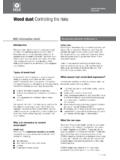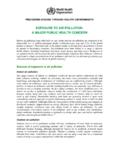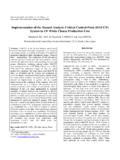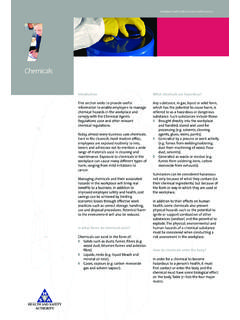Transcription of Get Control of Arena Dust - Footings Unlimited,arena ...
1 Get Control of Arena DustMake your summer riding more enjoyable with some of these suggestions to help you keep the dust you ever entered an Arena and felt like you were riding headlong into a sandstorm? A dusty Arena is unpleasant for riders, trainers and spectators alike, and it s not great for neighbor relations, either. Not only that, but frequent exposure to dust may pose significant health risks for you and your horse, as well as compromise his unless you can afford a high-tech polymer-fused sand footing such as Terra 2000 or Equation, which guarantee a dust -free Arena you re going to have to accept some dust as a fact of life.
2 How much dust do you have to put up with? Not that much, if you find the right prevention and Control s start with a look at some of the factors that are responsible for creating dust . Then, we ll consider various dust -suppression Just Dry WeatherDust consists of fine particles that become airborne. The particles can be clay, silt, pulverized sand or organics any substance that s small enough for air to suspend it. Of course, knowing what dust is doesn t necessary tell you where it s coming from, and a lot of misconceptions exist about what actually creates issues.
3 The first thing to look at is your base. A properly compacted base is essential to combating dust problems because it prevents the native soil from working its way to the surface. Native soil is full of fines, and if they get through the base and mix with your footing, your dust woes will escalate in a sufficiently compacted base will contribute a small amount of dust through the action of the footing material grinding against it, but it generally won t wear down more than one-eighth inch in a year. In low-traffic situations, dust from the base won t even be contrast, a base that wasn t well compacted can be a huge dust producer.
4 If the base fails and begins to break apart, it s going to wind up as dust . And if it loses its effectiveness as a barrier, it will allow the soil fines to come up to the surface and compound the isn t just caused by hot, dry days. As horses pound the footing, they break it down into smaller particles. The smaller the particles, the easier it is for them to become suspended in the air, causing s important to address any issues with your base before you tackle other potential sources of dust . Otherwise, you re always going to be battling dust , no matter what additional measures you issues.
5 Let s assume you have a sound base, but you still have dust . Now it s time to evaluate your Arena footing to see how it might be contributing to the dust turn into dust , footing materials need to become suspended in the air. That s why fresh, clean sand isn t dusty: The particles are too large and heavy to become airborne. Unfortunately, sand breaks down with use, and when it becomes fine enough, it will become a you have a sand footing, you can slow the breakdown process somewhat by adding a buffering material, such as crumb rubber or wood.
6 Such additives help reduce friction between sand particles and add some cushioning so they are less likely to be ground up. Even so, some of your sand will inevitably be pulverized into you bring in an unwashed sand, which may contain from 10 to 30% clay and silt particles or you add dirt to a sand footing you ll have dust from the get-go. This composition is the footing of choice for many western events, as well as for some dressage and hunter/jumper arenas, because it can provide more stability than clean sand.
7 Just bear in mind that clay and silt are fines, so they tend to get into the Managementl If a base isn t properly compacted, it will create dust Make sure the tines of your harrow are set high enough to avoid tearing up the Additives such as crumb rubber can help prevent footing breakdown, but only add it to fresh footing, not worn, already-dusty Be conservative when treating your Arena with a dust - Control agent. Apply a little and see how it works before adding Water is an effective dust suppressant but only if you water deeply, at least two inches into the the other hand, clay is one of nature s best sponges.
8 If it s well watered, it can actually improve your dust situation by holding moisture in the footing. Specialized clay additives, such as bentonite, are even used for dust other types of primary footing materials stone dust and wood are also dust producers. Stone dust consists of extremely fine particles, and moisture is needed to keep them out of the air. Wood breaks down into dust when it s allowed to dry out. (We re not counting polymer-coated sand, although it s a primary footing material, too. As we noted earlier, it s guaranteed not to produce dust .)
9 Once you determine what s causing the dust in your Arena , it becomes easier to evaluate your options to Control it. We ll consider the pros and cons of various approaches suppressants vary considerably, but their goal is the same: To make the dust too heavy to become airborne. Theyaccomplish this by coating dust particles, by making them stick together or your Arena seems extraordinarily dusty, you might check the base to see that it s properly compacted. With a good base, the native soil won t work its way to the surfaceto cause additional most prevalent means of controlling dust is by watering the Arena .
10 Watering coats particles and makes them stick together, and if done properly, it manages dust nicely. Unfortunately, many people water superficially, losing the Gregory, general manager of Footings Unlimited, says the biggest mistake people make when watering an Arena is that they don t water enough. If you water lightly, the water s going to sit in the top inch, he said. As soon as you go out and ride, you re going to bring up all that dry stuff. You want to water heavy and seldom. SaltsAfter water, the next most common dust suppressant is salt either calcium chloride or magnesium chloride.






